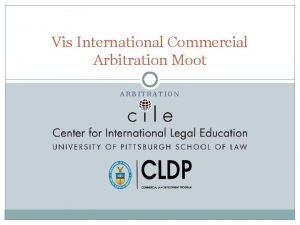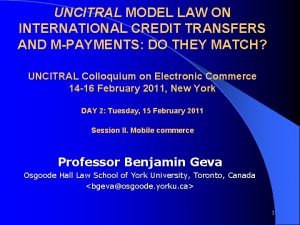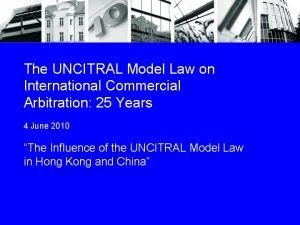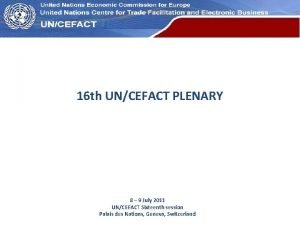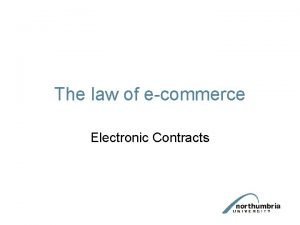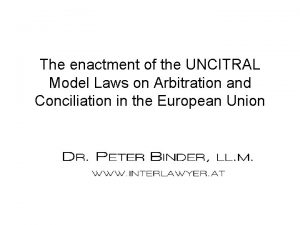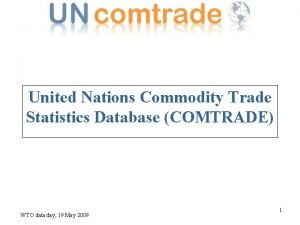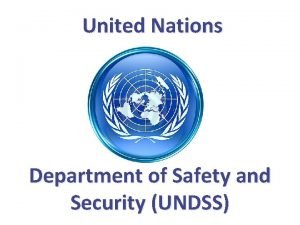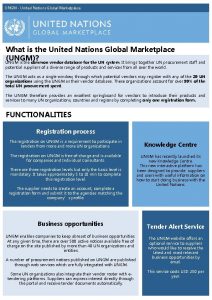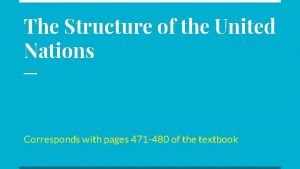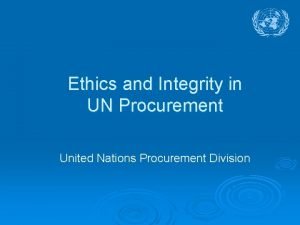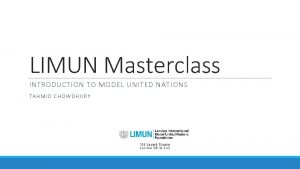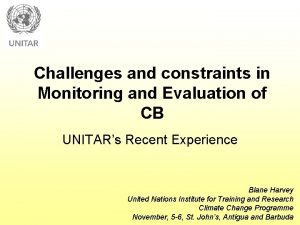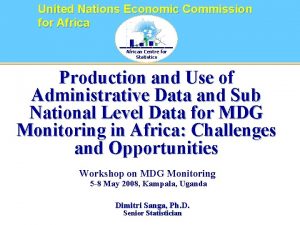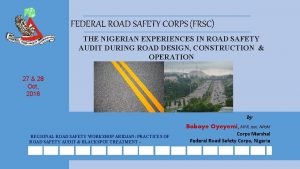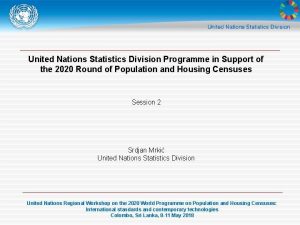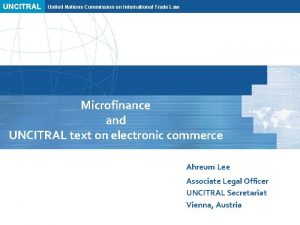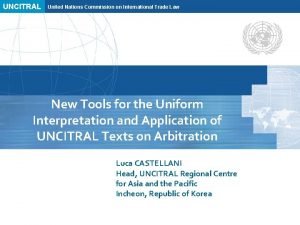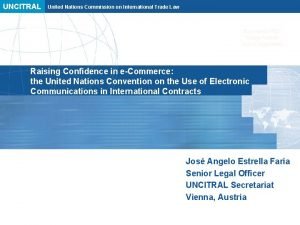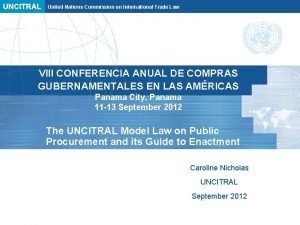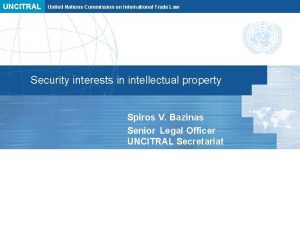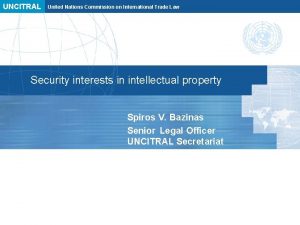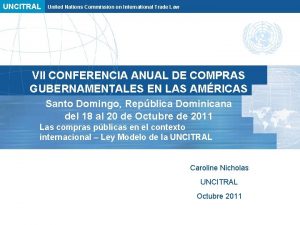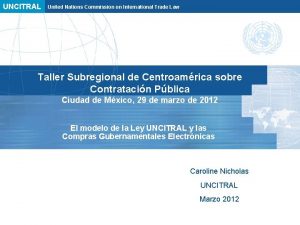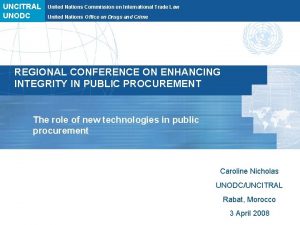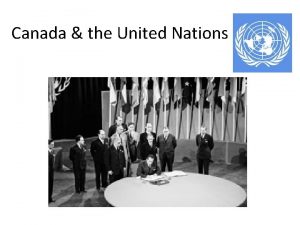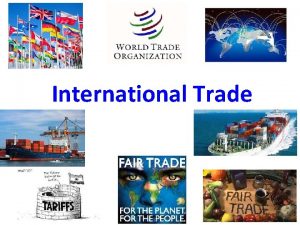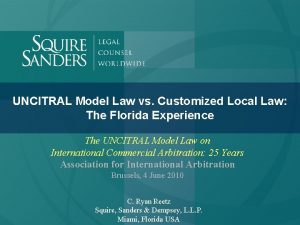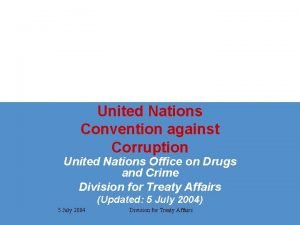UNCITRAL United Nations Commission on International Trade Law
























- Slides: 24

UNCITRAL United Nations Commission on International Trade Law < Making it easier to obtain credit > Possible reform of secured transactions regimes based on the UNCITRAL Model Law – Key Principles Jae Sung LEE Secretary of Working Group VI, UNCITRAL Legal Officer, International Trade Law Division Office of Legal Affairs, United Nations

When was UNCITRAL established? And why? UNCITRAL

Secretariat United Nations Org Structure UNCITRAL

The Commission 6 Working Groups • Working Groups The Secretariat I. Micro, medium & small-sized enterprises II. Arbitration III. Investor. State Dispute Settlement IV. Electronic Commerce V. Insolvency Law VI. Security Interests Two sessions per year alternating between New York (spring) and Vienna (fall) UNCITRAL

UNCITRAL Texts Convention Model Law Legislative Guide • Negotiated with universal participation and reflect balance of national, regional, economic, legal and other interest • Drafted with a view to ensure compatibility with the various legal traditions • Not necessarily international , texts UNCITRAL implemented domestically

Importance of getting credit • Access to credit is essential for businesses and thus, important for economic growth and sustainable development • Then, why is it difficult for businesses to get credit? • Lack of collateral which would be accepted by financial institutions (strong preference for immovable property) • Legal framework to facilitate lending based on movable asset needed to reduce the perceived risks of creditors and thus, to promote the availability of credit at a more affordable rate UNCITRAL

World Bank Doing Business indicator on Getting Credit • Assessment based on the ü the legal framework for secured transactions by examining whether collateral and bankruptcy laws facilitate lending (strength of legal rights index); and ü the coverage, scope and quality of credit information available through credit registries and bureaus (depth of credit information index) UNCITRAL

Strength of legal rights index • Movable assets as collateral (non-possessory security rights) – integrated and unified legal framework • Security right in a single category of movable assets • Security right in all assets of the grantor • Security rights in future assets • Extension of security rights to proceeds • Types of secured obligation • Registry in operation (functional approach) • Resolution of priority conflict among competing claimants UNCITRAL • Enforcement (out-of-court)

The need for reform • • To increase transparency and certainty of rights To balance the interest of the parties involved To increase level of access to credit To decrease the cost of credit à A legislative framework to support a modernized, well -functioning secured transactions system is key à Especially important for small and medium sized businesses UNCITRAL à New law or reforms of the existing law(s)

Creating a favourable environment for access to credit • United Nations Convention on the Assignment of Receivables in International Trade 2001 2007 • UNCITRAL Legislative Guide on Secured Transactions: Supplement on Security Rights in Intellectual Property 2010 2013 2016 2017 • UNCITRAL Guide on the Implementation of a Security Rights Registry • UNCITRAL Model Law on Secured Transactions • Guide to Enactment of the UNCITRAL Model Law on Secured Transactions [Explanatory text] UNCITRAL, Hague Conference and Unidroit Texts on UNCITRAL Security Interests: Comparison and analysis of major features of international instruments relating to secured transactions (2011)

UNCITRAL Model Law on Secured Transactions • A simple, concise Model Law based on the Legislative Guide, Registry Guide and the IP Supplement • Preparation began in fall of 2013 and adopted by the Commission in July 2016 • Unitary, functional & comprehensive approach to address multiplicity of regimes creating gaps and inconsistencies • Includes a set of model registry provisions UNCITRAL • Guide to enactment finalized in 2017

The Model Law Approach ü Movable assets as collateral (non-possessory security rights) – functional, integrated, unitary approach. Article 1. Scope of application 1. This Law applies to security rights in movable assets. Article 2. Definitions and rules of interpretation (kk) “Security right” means: (i) A property right in a movable asset that is created by an agreement to secure payment or other performance of an obligation, regardless of whether the parties have denominated it as a security right, and regardless of the type of asset, the status of the grantor or secured UNCITRAL creditor, or the nature of the secured obligation; …

The Model Law Approach ü Security right in a single category of movable assets, in all assets of the grantor, in future assets Article 6. Creation of a security right … 1. A security right is created by a security agreement, provided that the grantor has rights in the asset to be encumbered or the power to encumber it. 2. A security agreement may provide for the creation of a security right in a future asset, but the security right in that asset is created only when the grantor acquires rights in it or the power to encumber it. UNCITRAL

The Model Law Approach ü Generic description sufficient Article 9. Description of encumbered assets … 1. The encumbered assets and secured obligations must be described in the security agreement in a manner that reasonably allows their identification. 2. A description of encumbered assets that indicates that the encumbered assets consist of all the grantor’s movable assets, or of all the grantor’s movable assets within a generic category, satisfies the standard in paragraph 1. 3. … UNCITRAL

The Model Law Approach ü Extension of security rights to proceeds Article 10. Rights to proceeds and commingled funds 1. A security right in an encumbered asset extends to its identifiable proceeds. ü Types of secured obligation Article 7. Obligations that may be secured A security right may secure one or more obligations of any type, present or future, determined or determinable, conditional or unconditional, fixed or fluctuating. UNCITRAL

The Model Law Approach ü Distinction between creation and third-party effectiveness (advance registration possible!) ü Primary method for achieving third-party effectiveness (registration!) Article 18. 1. A security right in an encumbered asset is effective against third parties if a notice … is registered in the Registry. 2. A security right in an encumbered asset is effective against third parties if the secured creditor is in possession of the asset. UNCITRAL

The Model Law Approach ü Registry in operation (functional approach) Article 28. Establishment of the Registry A registry is established to give effect to the provisions of this Law relating to the registration of notices with respect to security rights. Model Registry Provisions Article 5. Conditions for access to registry services 1. Any person may submit a notice to the Registry, if that person: 2. … 3. Any person may submit a search request to the UNCITRAL Registry if that person:

The Model Law Approach ü Registry in operation (functional approach) • Electronic and public • Notice-based (vs. document-based) • Grantor-based indexing UNCITRAL

The Model Law Approach ü Resolution of priority conflict among competing claimants: clear and predictable priority rules Chapter V. Priority of a security right (Art. 29 -45) Article 29. Competing security rights created by the same grantor Article 34. Security rights competing with rights of buyers or other transferees, lessees or licensees of an encumbered asset Article 36. Security rights competing with preferential claims Article 37. Security rights competing with rights of UNCITRAL judgment creditors

The Model Law Approach ü Enforcement (out-of-court) Article 72. Post-default rights 1. After default, the grantor and the secured creditor are entitled to exercise: (a) Any right under the provisions of this chapter; and (b) Any other right provided in the security agreement or any other law, except to the extent it is inconsistent with the provisions of this Law. Article 73. Methods of exercising post-default rights 1. The secured creditor may exercise its post-default rights by application to [a court or other authority to be specified by the enacting State] or without such an application. UNCITRAL

The Model Law Approach ü Enforcement (out-of-court) Article 76. Right of a higher-ranking secured creditor to take over enforcement Article 77. Right of the secured creditor to obtain possession of an encumbered asset Article 78. Right of the secured creditor to dispose of an encumbered asset Article 79. Distribution of proceeds UNCITRAL

Key elements of a successful secured transactions law ü Enhances availability of secured credit ü Allows debtors to utilize the full value in their assets to support credit ü Enables parties to obtain security rights in a simple and efficient manner ü Establishes clear and predictable priority rules ü Facilitates efficient enforcement of creditor’s rights ü Allows parties maximum flexibility in negotiating the terms of the secured transaction UNCITRAL

Practice Guide to the Model Law on Secured Transactions VI. Security Interests • To provide practical guidance to parties involved in secured transactions and those that may be affected • To explain key features of the Model Law and how parties can engage in secured transactions • List transactions facilitated by the Model Law • Includes chapters on contractual, transactional and regulatory issues and deals with treatment of MSMEs • Preparation began in fall of 2017 and will continue in UNCITRAL New York in April

Thank You! For more information on the work of UNCITRAL, please visit our web site http: //www. uncitral. org E-mail: jaesung. lee@uncitral. org UNCITRAL
 Uncitral model law on international commercial arbitration
Uncitral model law on international commercial arbitration Mlict
Mlict Uncitral model law on electronic signatures
Uncitral model law on electronic signatures United nations economic commission for europe
United nations economic commission for europe Uncitral model law on electronic commerce
Uncitral model law on electronic commerce Uncitral model law on electronic signatures
Uncitral model law on electronic signatures Commodity trade statistics database
Commodity trade statistics database United nations
United nations United nation department of safety and security
United nation department of safety and security United nation global marketplace
United nation global marketplace Six main organs of the united nations
Six main organs of the united nations Role of united nations
Role of united nations Ethics and integrity at the united nations
Ethics and integrity at the united nations Introduction to model united nations
Introduction to model united nations Constraints in monitoring and evaluation
Constraints in monitoring and evaluation United nations zambia
United nations zambia United nations
United nations United nations
United nations What is mun
What is mun The agency sponsored by the united nations that compiles
The agency sponsored by the united nations that compiles Vision and mission of frsc
Vision and mission of frsc Christian saunders united nations
Christian saunders united nations United nations flag
United nations flag United nations statistics division
United nations statistics division Aitor arauz chapman
Aitor arauz chapman
